《人类减贫的中国实践》白皮书(双语全文)
新华网 2021-04-06 14:28

二、新时代脱贫攻坚取得全面胜利
II. Final Victory in the Fight Against Extreme Poverty
中共十八大以来,经过8年持续奋斗,到2020年底,中国如期完成新时代脱贫攻坚目标任务,现行标准下9899万农村贫困人口全部脱贫(图1),832个贫困县全部摘帽(图2),12.8万个贫困村全部出列,区域性整体贫困得到解决,完成消除绝对贫困的艰巨任务。
China's fight against poverty entered a critical stage after the 18th CPC National Congress in 2012. At the end of 2020, through eight years of hard work, China achieved the goal of eliminating extreme poverty – a key goal for the new era of building socialism with Chinese characteristics. The 98.99 million people in rural areas who were living below the current poverty threshold all shook off poverty (Figure 1); all the 128,000 impoverished villages and 832 designated poor counties got rid of poverty (Figure 2). China has eliminated poverty over entire regions and eradicated extreme poverty.
脱贫攻坚战对中国农村的改变是历史性的、全方位的,是中国农村的又一次伟大革命,深刻改变了贫困地区落后面貌,有力推动了中国农村整体发展,补齐了全面建成小康社会最突出短板,为全面建设社会主义现代化国家、实现第二个百年奋斗目标奠定了坚实基础。脱贫攻坚战全面胜利,中华民族在几千年发展历史上首次整体消除绝对贫困,实现了中国人民的千年梦想、百年夙愿。
The battle against poverty has been another great revolution in rural China, leading to historic and comprehensive changes. The campaign saw an end to the backwardness of poverty-stricken areas, boosted overall rural development, resolved the greatest threat to success in achieving moderate prosperity in all respects, and laid a solid foundation for building a modern socialist China and realizing the Second Centenary Goal. China has secured a complete victory in the battle against extreme poverty, eliminating overall and extreme poverty for the first time in its history of thousands of years, and realizing a century-long aspiration of the Chinese people.
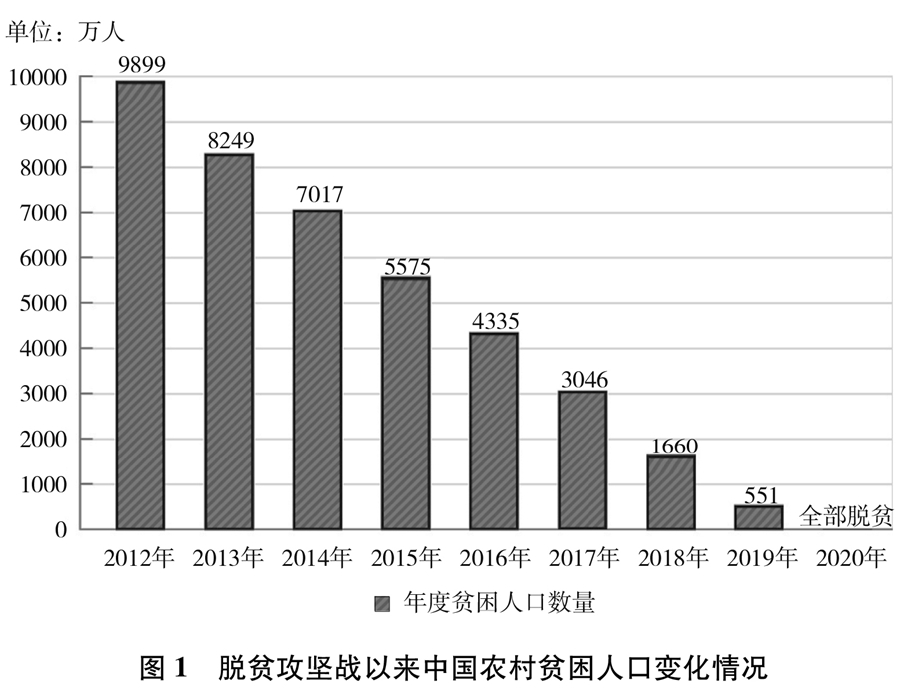

(一)贫困人口生活水平显著提升
1. Significant Improvement in the Living Standards of the Poor
经过脱贫攻坚战,贫困人口的收入和福利水平大幅提高,“两不愁三保障”全面实现,教育、医疗、住房、饮水等条件明显改善,既满足了基本生存需要,也为后续发展奠定了基础。脱贫攻坚的阳光照耀到每一个角落,贫困群众的生活发生了巨大变化。
Through poverty alleviation, there has been a substantial improvement in the incomes and welfare of the poor. The Two Assurances and Three Guarantees[ This refers to assurances of adequate food and clothing, and guarantees of access to compulsory education, basic medical services and safe housing for impoverished rural residents. ] have been realized; education, healthcare, housing and drinking water supplies are much improved. These provisions have covered all basic needs and laid the foundations for future development. The fight against poverty has led to dramatic changes in the lives of the impoverished.
贫困人口收入水平持续提升(图3)。贫困地区农村居民人均可支配收入,从2013的6079元增长到2020年的12588元,年均增长11.6%,增长持续快于全国农村,增速比全国农村高2.3个百分点。贫困人口工资性收入和经营性收入占比逐年上升,转移性收入占比逐年下降,自主增收脱贫能力稳步提高。少数民族和民族地区脱贫攻坚成效显著,2016年至2020年,内蒙古自治区、广西壮族自治区、西藏自治区、宁夏回族自治区、新疆维吾尔自治区和贵州、云南、青海三个多民族省份贫困人口累计减少1560万人。28个人口较少民族全部实现整族脱贫,一些新中国成立后“一步跨千年”进入社会主义社会的“直过民族”,又实现了从贫穷落后到全面小康的第二次历史性跨越。
The incomes of the impoverished are increasing (Figure 3). The per capita disposable income of the rural poor increased from RMB6,079 in 2013 to RMB12,588 in 2020, up by 11.6% per annum on average. The growth rate was 2.3 percentage points higher than the national rural average. Their salary income and operative income kept increasing over the years in proportion to their transfer income, showing a stronger ability to shake off poverty through their own efforts. Ethnic minority areas have made notable progress in fighting poverty. From 2016 to 2020, in the five autonomous regions (Inner Mongolia, Guangxi, Tibet, Ningxia and Xinjiang) and three provinces with a large multi-ethnic population (Guizhou, Yunnan and Qinghai), the number of the poor dropped by 15.6 million. Extreme poverty was eliminated in all 28 of the minority ethnic groups with a small population. Some ethnic groups, still at the later stage of primitive society when the PRC was founded in 1949, leapfrogged to socialism and then again made great strides towards moderate prosperity in all respects.

“两不愁三保障”全面实现。脱贫攻坚普查显示,贫困户全面实现不愁吃、不愁穿,平时吃得饱且能适当吃好,一年四季都有应季的换洗衣物和御寒被褥。贫困人口受教育的机会显著增多、水平持续提高,农村贫困家庭子女义务教育阶段辍学问题实现动态清零,2020年贫困县九年义务教育巩固率达到94.8%。持续完善县乡村三级医疗卫生服务体系,把贫困人口全部纳入基本医疗保险、大病保险、医疗救助三重制度保障范围,实施大病集中救治、慢病签约管理、重病兜底保障等措施,99.9%以上的贫困人口参加基本医疗保险,全面实现贫困人口看病有地方、有医生、有医疗保险制度保障,看病难、看病贵问题有效解决。实施农村危房改造,贫困人口全面实现住房安全有保障(专栏1)。实施农村饮水安全和巩固提升工程,累计解决2889万贫困人口的饮水安全问题,饮用水量和水质全部达标,3.82亿农村人口受益;贫困地区自来水普及率从2015年的70%提高到2020年的83%。
The Two Assurances and Three Guarantees have been realized. According to the national survey of poverty alleviation[ The national survey of poverty alleviation is a full review of China's progress in fighting poverty and has a fundamental importance for targeted poverty alleviation. From 2020 to 2021, the survey was conducted in 22 provinces and equivalent administrative units in central and western China, focusing on the veracity of poverty alleviation results, particularly the overall progress in designated poor counties. The survey includes registration of poverty-stricken populations, progress in the Two Assurances and Three Guarantees, participation of the impoverished in poverty alleviation programs, and basic public services in poor counties and villages. ], poor households now have adequate food and clothing all year round and a proper supply of nutritious food. They have clothing for all four seasons and comforters that protect them from cold weather. Access to good quality education for the impoverished has improved remarkably; there are no dropouts in the countryside due to financial difficulties; nine-year compulsory education is now available to all children from rural poor households, and the completion rate in 2020 was 94.8%. The three-tier healthcare system at village, township and county levels has been improved. All poverty-stricken populations now have access to basic medical insurance, critical illness insurance, and medical assistance, to ensure medical treatment to the impoverished with major illnesses, contracted healthcare to the impoverished with chronic diseases, and guaranteed medical services for the impoverished with critical illnesses. Basic medical insurance coverage of the poor is now over 99.9%. All the impoverished have been guaranteed medical services and medical insurance. Through these measures, China has resolved the problem of difficult and expensive access to medical treatment for poverty-stricken residents. The program of renovation of dilapidated rural homes has ensured safe housing for all the impoverished (Box 1). The program of safe drinking water for rural residents has secured supplies to 28.89 million poor in terms of both quantity and quality, and benefited 382 million rural population; tap water coverage increased from 70% in 2015 to 83% in 2020.
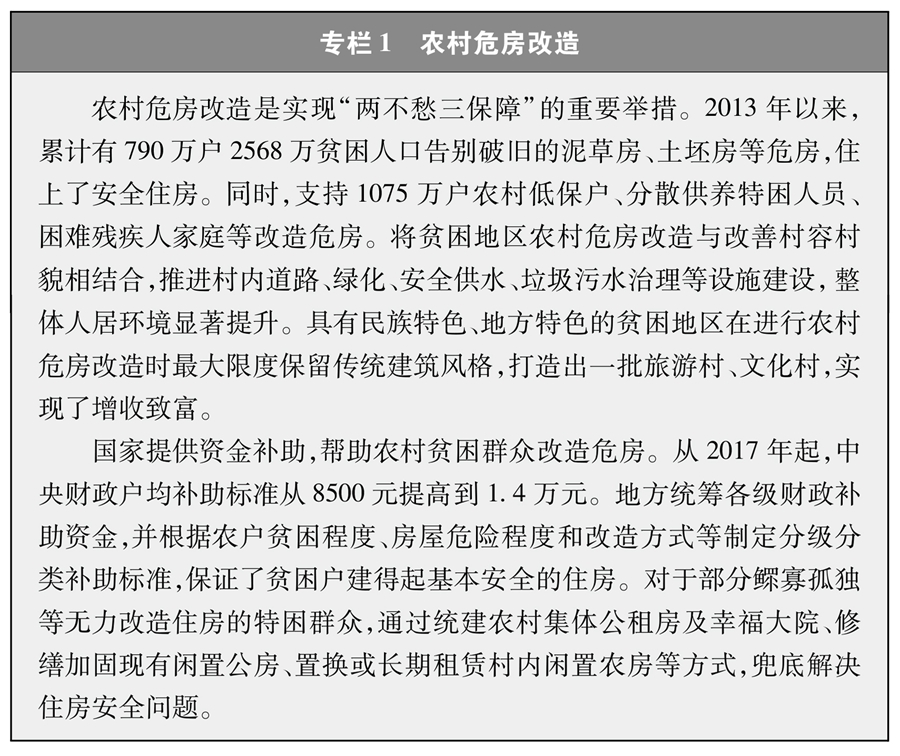
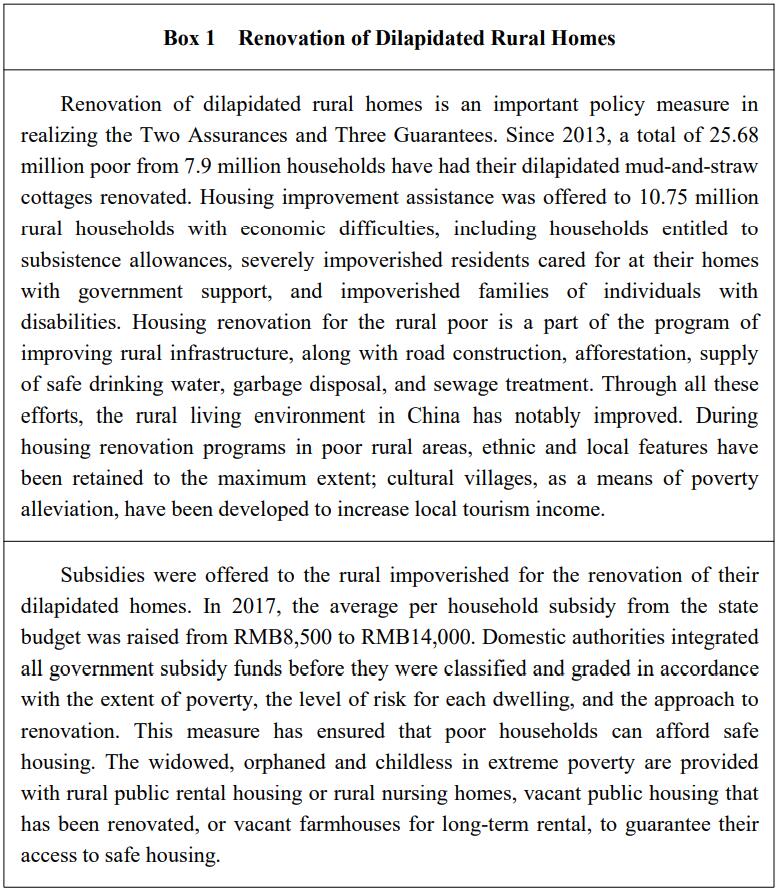
(二)贫困地区落后面貌根本改变
2. Poverty-stricken Areas Rid of Backwardness
长期以来,贫困地区基础设施薄弱,公共服务匮乏,经济社会发展滞后。脱贫攻坚战不仅使农村贫困人口全部脱贫,而且使贫困地区经济社会发展大踏步赶上来,整体面貌发生历史性巨变。
Poor areas have long suffered from weak infrastructure, inadequate public services, and social and economic underdevelopment. In the final stages of fighting poverty, China succeeded in raising all the rural poor out of extreme poverty and the impoverished areas achieved a big stride in economic and social development, taking on a brand new look.
基础设施显著改善。出行难、用电难、用水难、通信难,是长期以来制约贫困地区发展的瓶颈。把基础设施建设作为脱贫攻坚基础工程,集中力量,加大投入,全力推进,补齐了贫困地区基础设施短板,推动了贫困地区经济社会快速发展。以建好、管好、护好、运营好农村公路(简称“四好农村路”,专栏2)为牵引,积极推进贫困地区建设外通内联、通村畅乡、客车到村、安全便捷的交通运输网络。截至2020年底,全国贫困地区新改建公路110万公里、新增铁路里程3.5万公里,贫困地区具备条件的乡镇和建制村全部通硬化路、通客车、通邮路,贫困地区因路而兴、因路而富。努力改善贫困地区水利基础设施条件,2016年以来,新增和改善农田有效灌溉面积8029万亩,新增供水能力181亿立方米,水利支撑贫困地区发展的能力显著增强。大幅提升贫困地区用电条件,实施无电地区电力建设、农村电网改造升级、骨干电网和输电通道建设等电网专项工程,把电网延伸到更多偏远地区,农村地区基本实现稳定可靠的供电服务全覆盖,供电能力和服务水平明显提升(专栏3)。加强贫困地区通信设施建设,贫困村通光纤和4G比例均超过98%,远程教育加快向贫困地区学校推进,远程医疗、电子商务覆盖所有贫困县,贫困地区信息化建设实现跨越式发展。基础设施的极大改善,从根本上破解了贫困地区脱贫致富的难题,畅通了贫困地区与外界的人流、物流、知识流、信息流,为贫困地区发展提供了有力的硬件支撑。
Poor areas have long suffered from weak infrastructure, inadequate public services, and social and economic underdevelopment. In the final stages of fighting poverty, China succeeded in raising all the rural poor out of extreme poverty and the impoverished areas achieved a big stride in economic and social development, taking on a brand new look. Infrastructure has been improved. Lack of access to transport, electricity, drinking water and communications hinders the development of poverty-stricken areas. Infrastructure construction is a basic element in the battle against poverty; through an intensified effort and further investment, new infrastructure in poor areas boosted their social and economic development. The construction, management, maintenance and operation of roads in rural areas have all seen significant improvement (Box 2). Transport networks now connect all villages with other local villages and with the outside world, and provide them with safe and easy access to bus services. By the end of 2020, impoverished areas had gained 1.1 million km of reconstructed highways and 35,000 km of new railways; all the villages, townships and towns in poverty-stricken areas with the right conditions were accessible by paved road and provided with bus and mail routes, which facilitated more economic development. Water infrastructure in impoverished areas has been improved in many ways. Since 2016, the effective irrigated area has increased by more than 5.35 million ha and water supply capacity has increased by 18.1 billion cu m. Better water infrastructure is also a provider of strong support for the development of poverty-stricken areas. Electricity access in poor areas has been improved through power grid construction projects such as power supply to areas without electricity, upgrading of rural power grids, and construction of trunk power grids and power transmission channels. Now, more remote areas are connected to power grids, and almost all rural areas enjoy a steady power supply (Box 3). Communications infrastructure has been extended in poverty-stricken areas. Now, over 98% of poor villages have access to optical fiber communications (OFC) and 4G technology; distance education is available at more schools in impoverished areas; telemedicine and e-commerce cover all designated poor counties. All of this represents an unprecedented pace of development of IT application in poverty-stricken areas. This comprehensive range of infrastructure improvements has resolved many historical problems trapping poor areas in poverty, facilitated the flows of personnel, logistics, knowledge and information between poor areas and the outside world, and provided solid support for social and economic development in impoverished areas.
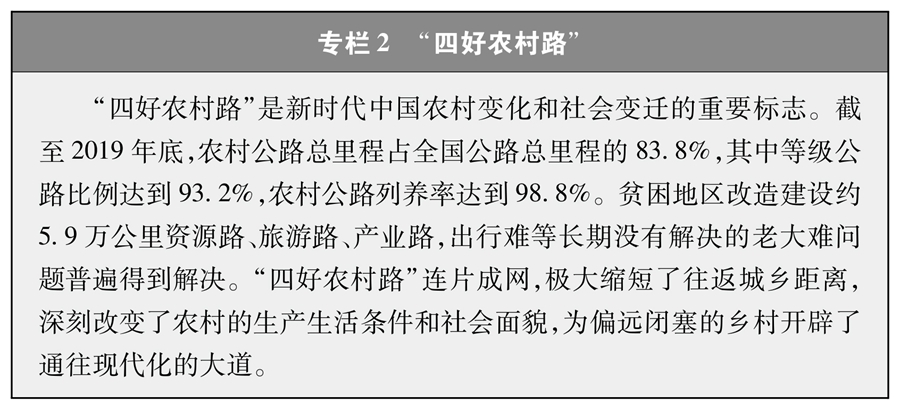
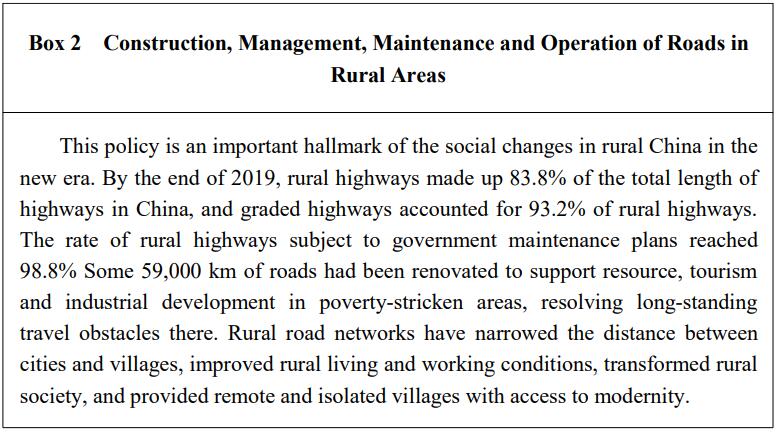
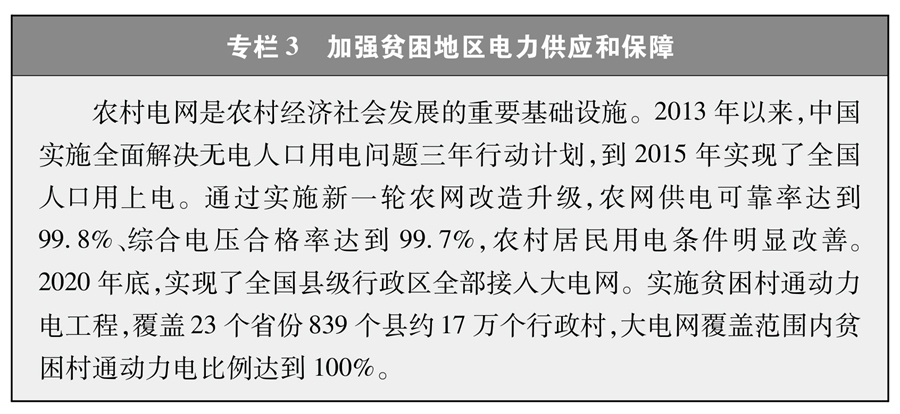

基本公共服务水平明显提升。在解决好贫困人口吃饭、穿衣、居住等温饱问题基础上,大力提升贫困地区教育、医疗、文化、社会保障等基本公共服务水平,实现贫困人口学有所教、病有所医、老有所养、弱有所扶,为贫困地区发展夯实基础、积蓄后劲。2013年以来,累计改造贫困地区义务教育薄弱学校10.8万所,实现贫困地区适龄儿童都能在所在村上幼儿园和小学。贫困地区公共文化服务水平不断提高,截至2020年底,中西部22个省份基层文化中心建设完成比例达到99.48%,基本实现村级文化设施全覆盖;持续推进文化下乡,贫困群众也有了丰富多彩的业余文化生活。贫困地区医疗条件显著改善,消除了乡村两级医疗卫生机构和人员“空白点”,98%的贫困县至少有一所二级以上医院,贫困地区县级医院收治病种中位数达到全国县级医院整体水平的90%,贫困人口的常见病、慢性病基本能够就近获得及时诊治,越来越多的大病在县域内就可以得到有效救治。综合保障体系逐步健全,贫困县农村低保标准全部超过国家扶贫标准,1936万贫困人口纳入农村低保或特困救助供养政策;6098万贫困人口参加了城乡居民基本养老保险,基本实现应保尽保。
Basic public services have been improved. In addition to providing adequate food, clothing and safe housing for the impoverished, China has intensified efforts to improve basic public services covering education, healthcare, culture and social security. The goal is to guarantee impoverished people access to education, medical services, elderly care and social assistance, so as to support development in poverty-stricken areas. Since 2013, China has renovated 108,000 schools to strengthen the provision of compulsory education in poor areas, and ensured that all school-age rural children receive kindergarten and elementary education within their own villages. Public cultural services in poor areas have also been improved. By the end of 2020, 99.48% of villages in 22 provinces and equivalent administrative units in central and western China had seen their own cultural centers completed. The campaign of bringing culture to the countryside has enriched the cultural life of the rural poor. There has been a notable improvement in healthcare provision in poor areas. This program has remedied the shortfall in medical workers and institutions at village and township level. 98% of the designated poor counties now have at least one grade-two hospital. The county-level hospitals in impoverished areas can treat 90% of the diseases that general county-level hospitals can. The impoverished can now have common ailments and chronic diseases treated at nearby medical institutions in a timely manner, and more major illnesses can be effectively treated at county-level hospitals. Comprehensive social security systems are now in place in poor areas. The standards of eligibility for rural subsistence allowances in designated poor counties are all higher than the national poverty threshold. Some 19.36 million impoverished people have been covered by rural subsistence allowances or extreme poverty relief funds, and 60.98 million by basic pension schemes for rural and non-working urban residents, achieving nearly 100% coverage.
经济持续快速发展。脱贫攻坚极大释放了贫困地区蕴含的潜力,为经济发展注入强大动力。产业结构显著改善,特色优势产业不断发展,电子商务、光伏、旅游等新业态新产业蓬勃兴起,推动了贫困地区经济多元化发展,扩大了市场有效供给,厚植了经济发展基础。贫困地区的地区生产总值持续保持较快增长,2015年以来,人均一般公共预算收入年均增幅高出同期全国平均水平约7个百分点。收入的持续稳定增长,激发了贫困群众提升生活品质、丰富精神文化生活的需求,拉动了庞大的农村消费,为促进国内大循环提供了支撑。
The economy has achieved sustained and rapid growth. The battle against poverty has released the potential of poor areas, and injected vigor into their economic development. Poverty-stricken areas have seen notable improvements in their economic structure. Businesses that leverage local strengths have been growing and thriving, including such new forms as e-commerce, photovoltaic technology, and tourism. The economy in poor areas has diversified, and effective market supply has increased. These developments provide solid foundations for economic growth. The GDP of impoverished areas has maintained rapid growth. Since 2015, the average annual increment in per capita revenue from the national general public budget has been seven percentage points higher than the national average. A steady increase in incomes has created higher demand for life quality and cultural activities. This has stimulated a surge in consumption in rural areas, and provided support for the domestic economy.
优秀文化传承弘扬。加强贫困地区传统文化、特色文化、民族文化的保护、传承和弘扬,贫困地区优秀文化繁荣发展。实施国家传统工艺振兴工程,引导和推动革命老区、民族地区、边疆地区、贫困地区保护好、发展好当地优秀传统技艺。支持贫困地区深入挖掘民族文化、红色文化、乡土文化、非物质文化遗产特色资源,加强保护研究、人才培养、展示推广,打造特色文化旅游产业。开展留存扶贫印记活动,建立贫困村扶贫档案,鼓励支持扶贫题材影视文艺作品创作,生动记录脱贫致富历程。贫困地区优秀文化的保护传承,既促进了贫困群众增收致富,也延续了文脉、留住了乡愁。
Cultural heritage has been protected. China has strengthened the protection and promotion of traditional culture, folk culture and ethnic culture in poor areas to maintain a wealth of cultural diversity. It has implemented the Plan on the Revitalization of Traditional Chinese Craftsmanship to protect and develop fine craftsmanship in old revolutionary base areas, areas with large ethnic minority populations, border areas, and poverty-stricken areas. It has supported poor areas to develop cultural resources with local characteristics, including ethnic culture, revolutionary sites, folk culture, and intangible cultural heritage. Local governments in poor areas have developed tourism there by conserving and promoting these cultural resources and training support staff. China has paid attention to keeping a record of the experiences of ordinary people in poverty alleviation, such as archives of poor villages, films, TV programs and literary works themed on poverty alleviation. Through the protection and promotion of cultural heritage in poor areas, the impoverished have gained additional income while retaining their cultural roots.
生态环境更美更好。将扶贫开发与水土保持、环境保护、生态建设相结合,通过生态扶贫、农村人居环境整治、生态脆弱地区易地扶贫搬迁等措施,贫困地区生态保护水平明显改善,守护了绿水青山、换来了金山银山。脱贫攻坚既促进了贫困人口“增收”,又促进了贫困地区“增绿”,极大改善了贫困地区生态环境,广大农村旧貌换了新颜,生态宜居水平不断提高。
The eco-environment has improved. China has integrated development-driven poverty alleviation with soil and water conservation and eco-environmental conservation. By developing the eco-economy, improving the rural living environment, and relocating the impoverished from inhospitable areas to places with better economic prospects, there have been remarkable improvements in the eco-environment of poverty-stricken areas. Lucid waters and lush mountains have become their invaluable assets. Through the fight against poverty, China has increased the incomes of the impoverished, improved the eco-environment of poor areas, and made the vast rural areas more livable spaces for their inhabitants.
深度贫困地区是贫中之贫、坚中之坚。通过脱贫攻坚,“三区三州”等深度贫困地区突出问题得到根本解决,基础设施和公共服务水平显著提升,特色主导产业加快发展,社会文明程度明显提高,区域性整体贫困问题彻底解决(专栏4)。
Severely impoverished areas are the top priority in China's battle against poverty. The "three areas and three prefectures"[ The "three areas" refer to the Tibet Autonomous Region, the Hotan, Aksu, Kashgar prefectures and the Kizilsu Kirgiz Autonomous Prefecture in southern Xinjiang, and prefectures and counties with large Tibetan populations in the provinces of Sichuan, Yunnan, Gansu and Qinghai. The "three prefectures" refer to the Liangshan Yi Autonomous Prefecture in Sichuan Province, the Nujiang Lisu Autonomous Prefecture in Yunnan Province, and the Linxia Hui Autonomous Prefecture in Gansu Province. ] in extreme poverty have seen notable improvements in infrastructure, public services, and civil communal behavior, as well as rapid development in industries and businesses that leverage local strengths. All of these efforts have brought an end to regional and overall poverty (Box 4).

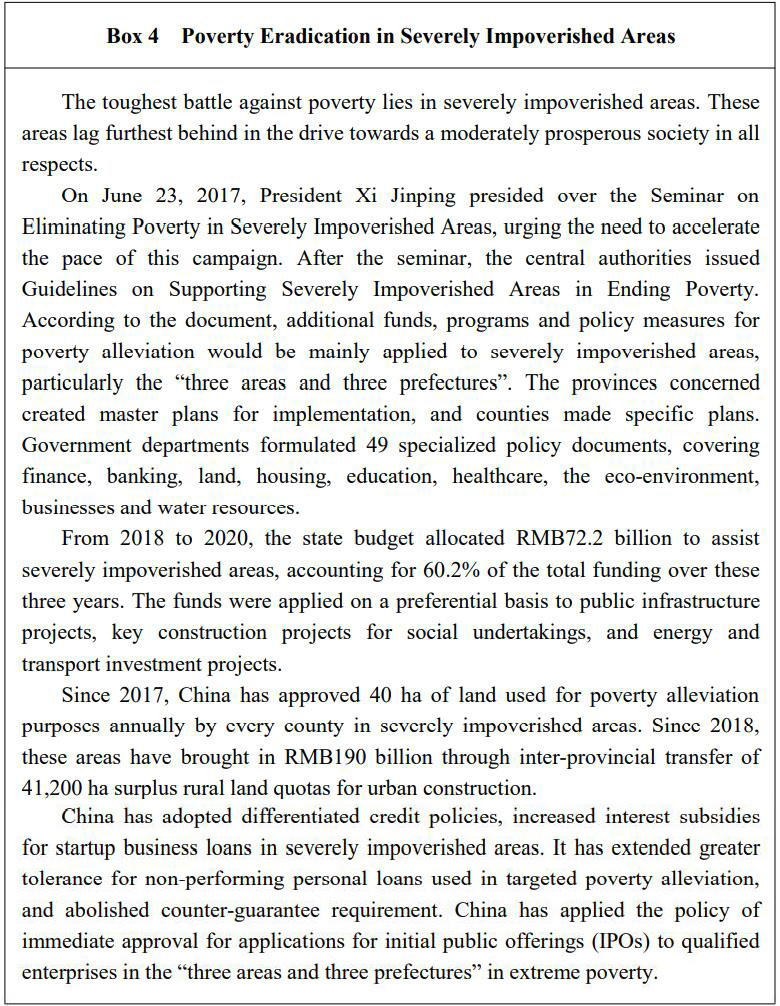
(三)脱贫群众精神风貌焕然一新
3. Those Who Have Been Lifted Out of Poverty Adopt a New Mindset
脱贫攻坚既是一场深刻的物质革命,也是一场深刻的思想革命;既取得了物质上的累累硕果,也取得了精神上的累累硕果。贫困群众的精神世界在脱贫攻坚中得到充实和升华,信心更坚、脑子更活、心气更足,发生了从内而外的深刻改变。
The battle against poverty is a profound revolution and complete victory on both material and theoretical level. Through this battle, the mindset of the poor has been enriched and sublimed – they have greater confidence, more active minds, and higher aspirations; they have experienced a thorough transformation from the inside to the outside.
脱贫致富热情高涨。脱贫攻坚不仅使贫困群众拓宽了增收渠道、增加了收入,而且唤醒了贫困群众对美好生活的追求,极大提振和重塑了贫困群众自力更生、自强不息,勤劳致富、勤俭持家,创业干事、创优争先的精气神,增强了脱贫致富的信心和劲头。“好日子是干出来的”,贫困群众比着把日子往好里过,依靠自己的辛勤劳动摆脱贫困,形成了你追我赶奔小康的浓厚氛围。
The impoverished have a deep desire to rid themselves of the shackles of poverty and achieve prosperity. The poverty relief efforts have not only widened channels for the impoverished to improve their material welfare but rekindled their desire to seek a better life as well. Impoverished people have been inspired to seek prosperity through hard work, self-reliance, frugality and entrepreneurship, and strive for excellence. They are highly motivated and have more confidence about getting rid of poverty. As the Chinese people always say, "Good days come after hard work". They are ready to compete in the race to prosperity.
主人翁意识显著提升。脱贫攻坚为贫困群众参与集体事务搭建了新的平台。扶贫项目实施、资金使用等村级重大事项决策,实行“四议两公开”,建立健全村务监督机制,推广村民议事会、扶贫理事会等制度,让村民做到“大家的事大家议、大家办”,拓展了贫困群众参与脱贫攻坚的议事管事空间,提高了参与集体事务的积极性自觉性,激发了建设家乡的热情,乡村发展的凝聚力大大增强。
The impoverished have a stronger sense of self-reliance. The poverty alleviation work has set up a new platform for the impoverished to participate in collective affairs. When making major decisions on the implementation of poverty relief projects and the use of funds at the village level, villagers have carried out a "4+2" system[ "4+2" system refers to the democratic policy-making process on village affairs under the leadership of village Party organizations. "4" means four steps: Proposals should be put forward by the Party branch, jointly discussed by the village committee and the Party branch, and deliberated by Party members, and resolutions should be adopted by villagers' representatives; "2" means transparency on two levels – resolutions and implementation results should be made known to the public. ]. The oversight mechanisms for village affairs and villagers' councils and poverty relief councils have been improved to ensure that public affairs are discussed and handled by everyone. Under these arrangements, the impoverished have participated more in the decision making and implementation process in the battle against poverty. They have been more motivated to participate actively in collective affairs, more enthusiastic to build up their hometown, and more cohesive to develop the countryside.
现代观念不断增强。脱贫攻坚打开了贫困地区通往外部世界的大门。交通基础设施的改善打通了贫困地区与外界的联系,公共文化事业的发展丰富了贫困群众的精神文化生活,网络的普及让贫困群众增长了见识、开阔了视野。贫困群众的开放意识、创新意识、科技意识、规则意识、市场意识等显著增强,脱贫致富的点子越来越多、路子越来越宽。
The impoverished have been constantly upgrading their mindsets. The battle against poverty has opened the door to the outside world for poverty-stricken areas. Improvements in transport infrastructure have established links between poor areas and the outside world; development of public cultural undertakings has enriched the cultural life of impoverished people; with better access to the internet, the poor have greater knowledge, broader horizons, and a deeper understanding of openness, innovation, technology, rules and markets. They are capable of generating more ideas and opening wider channels for poverty alleviation.
文明新风广泛弘扬。深化贫困地区文明村镇和文明家庭、“五好”家庭创建,持续推进新时代文明实践中心建设,发挥村规民约作用,推广道德评议会、红白理事会等做法,开展移风易俗行动,开展弘扬好家风、“星级文明户”评选、寻找“最美家庭”等活动,社会主义核心价值观广泛传播,贫困地区文明程度显著提升。俭朴节约、绿色环保、讲究卫生等科学、健康、文明的生活方式成为贫困群众的新追求,婚事新办、丧事简办、孝亲敬老、邻里和睦、扶危济困、扶弱助残等社会风尚广泛弘扬,既有乡土气息又有现代时尚的新时代乡村文明新风正在形成。
Cultural and ethical work has been advancing in impoverished regions. Civility villages and towns are being built in poverty-stricken areas, and civil families cultivated under the "Five Family Virtues" program (encouraging respect for the law, diligent study, family planning, domestic harmony, and industrious and thrifty management of the household). Social etiquette, village rules, agreements among villagers, and councils on moral issues, weddings and funerals have been promoted, to update outmoded and undesirable habits and customs. Activities, such as competition for best households and families, have been organized to carry forward cherished family traditions, spread core socialist values, and enhance social etiquette and civility. Scientific, healthy and civilized new ways of life which are simple, green, eco-friendly, and hygienic have been embraced by the villagers. Good social practices, including modest weddings and funerals, filial piety, harmonious neighborhoods, and helping the needy, the weak and the disabled, have been promoted. In the new era, new cultural practices with a local and modern essence are developing in rural areas.
(四)特殊困难群体生存发展权利有效保障
4. Protecting the Rights of Special Groups to Basic Needs and Development
中国高度重视妇女、儿童、老人和残疾人等群体中特殊困难人员的生存和发展,采取特殊政策,加大帮扶力度,特殊困难群体的福利水平持续提高,生存权利充分保障,发展机会明显增多。
China prioritizes the basic rights of subsistence and development of the disadvantaged groups among women, children, the elderly, and the disabled. The nation has enacted favorable policies and provided more assistance to raise the welfare level of these groups.
贫困妇女生存发展状况显著改善。坚持男女平等基本国策,将妇女作为重点扶贫对象,实现脱贫的近1亿贫困人口中妇女约占一半。实施《中国妇女发展纲要(2011-2020年)》,把缓解妇女贫困程度、减少贫困妇女数量放在优先位置,扶贫政策、资金、措施优先向贫困妇女倾斜,帮助贫困妇女解决最困难最忧虑最急迫的问题。累计对1021万名贫困妇女和妇女骨干进行各类技能培训,500多万名贫困妇女通过手工、种植养殖、家政、电商等增收脱贫。累计发放妇女小额担保贷款和扶贫小额信贷4500多亿元,870万名妇女通过小额担保贷款和扶贫小额信贷实现创业增收。19.2万名贫困患病妇女获得救助,妇女宫颈癌、乳腺癌免费检查项目在贫困地区实现全覆盖。通过“母亲水窖”“母亲健康快车”“母亲邮包”等公益项目,投入公益资金41.7亿元,惠及贫困妇女5000余万人次。
Living conditions of impoverished women have been improving. China adheres to the fundamental national policy of gender equality, and sees women as a key target in poverty alleviation. Among nearly 100 million who have shaken off poverty, women account for half. By implementing the Outline of Women's Development in China (2011-2020), China has given priority to helping women alleviate poverty and reducing the number of women in poverty, given preferential treatment to women when making poverty alleviation policies, allocated funds and taken measures, and helped them solve the most difficult, most worrying and most pressing problems. A total of 10.21 million impoverished women have received skills training, over 5 million of whom have increased their incomes through activities such as handicrafts, crop and animal husbandry, housekeeping and e-business. Small-sum guaranteed loans and micro credit amounting to more than RMB450 billion have been provided to impoverished women, which have helped 8.7 million women to start businesses and increase their incomes. China has assisted 192,000 women who suffer from poverty and diseases and launched a program of free cervical and breast cancer checkups to cover all women in poverty-stricken areas. RMB4.17 billion has been invested in titled campaigns to provide 50 million impoverished mothers in impoverished areas with infrastructure and health benefits, as well as daily necessities.
困境儿童关爱水平明显提高。实施《中国儿童发展纲要(2011-2020年)》《国家贫困地区儿童发展规划(2014-2020年)》,对儿童教育和健康实施全过程保障和干预。开展儿童营养知识宣传和健康教育,实施贫困地区儿童营养改善项目,提高贫困地区儿童健康水平,为集中连片特困地区6-24月龄婴幼儿每天免费提供1包辅食营养补充品,截至2020年底,累计1120万儿童受益。实施出生缺陷干预救助项目,为先天性结构畸形、部分遗传代谢病和地中海贫血贫困患病儿童提供医疗费用补助,累计救助患儿4.1万名,拨付救助金4.7亿元。组织各类志愿者与孤儿、农村留守儿童、困境儿童结对,开展关爱帮扶,覆盖儿童和家长2519.2万人次。建立儿童之家28万余所、儿童快乐家园1200余个,为留守、困境儿童提供文体娱乐、心理疏导、生活照顾、家教指导等关爱服务。大幅提高孤儿保障水平,机构集中养育孤儿和社会散居孤儿平均保障标准分别达到每人每月1611.3元和1184.3元。实施孤儿医疗康复明天计划项目,累计投入17亿元、惠及22.3万名病残孤儿。实施福彩梦圆孤儿助学工程,累计投入5.4亿元、惠及在校就读孤儿5.4万人次。建立事实无人抚养儿童保障制度,25.3万名事实无人抚养儿童参照当地孤儿保障标准纳入保障范围。
Extending greater care to deprived children. China has implemented the Outline on the Development of Chinese Children (2011-2020) and the National Development Plan for Children in Poor Areas (2014-2020) to provide security for children's education and health and deliver interventions when required. Efforts have been made to popularize knowledge on children's nutrition and health. Following the implementation of nutritional improvement projects for children in impoverished areas, children in these regions now enjoy better health. The government gives a free daily pack of nutritional dietary supplements to every baby and toddler aged 6-24 months in contiguous destitute areas. By the end of 2020, a total of 11.2 million children in those areas had benefitted from this project. Birth defect prevention & relief programs have been launched to help cover medical expenses for children who suffer from poverty and serious diseases such as congenital malformations, some inherited metabolic disorders, and thalassemia. A total of RMB470 million has been allocated for the care of 41,000 sick children. China has organized volunteers to pair up with orphans, deprived children, and children of migrant workers left at home in the countryside, providing care and help to 25.19 million children and parents. More than 280,000 children's homes and over 1,200 children's happy homes have been built to give entertainment, psychological counseling, life care and tutoring to deprived children and children of migrant workers left at home in the countryside. China continues to improve the protection of orphans' rights and interests, with monthly allowance for orphans in welfare institutions and families that provide temporary care totaling RMB1,611 and RMB1,184 per person respectively. China has invested RMB1.7 billion in the Tomorrow Plan for Rehabilitation of Handicapped Orphans to offer operations and rehabilitation to 223,000 orphans with disabilities. RMB540 million from the public welfare has been used to carry out a program to support school education for 54,000 orphans. A support system for de facto orphans has been established in China to cover 253,000 such children.
贫困老年人生活和服务保障显著改善。持续提高农村养老金待遇和贫困老年人口医疗保障水平,农村老年人口贫困问题进一步解决。经济困难的高龄、失能等老年人补贴制度全面建立,惠及3689万老年人。实施老年健康西部行项目,在西部贫困地区开展老年健康宣传教育,组织医务人员、志愿者开展义诊和健康指导服务,促进西部老年人健康素养和健康水平提高。建立农村留守老年人关爱服务制度,推动贫困老年人医疗保障从救治为主向健康服务为主转变。加强失能贫困老年人关爱照护,全面开展核查,确认62.7万失能贫困老年人,落实家庭医生签约服务59万人,失能贫困老年人健康状况明显改善。
Continuing to provide services and improve the lives of impoverished senior citizens. China has raised the amount of basic pension in rural areas and subsidies for basic medical insurance for poor seniors to further reduce poverty among the elderly in rural areas. The subsidy system for the poor population of advanced age and incapacitated seniors has been put in place, benefiting 36.89 million people. The government has initiated a program for the elderly in the western regions to promote health awareness among seniors in poverty-stricken areas, and organized medical workers and volunteers to provide free medical services and offer advice on health matters. China has developed a system to support and care for elderly people left behind by their families in the countryside after their grown-up children have moved to the cities in search of employment. It has shifted the focus of medical security for the impoverished elderly from medical treatment to health services. More care has been provided for incapacitated seniors living below the poverty line. On the basis of an overall inspection, China has verified 627,000 impoverished seniors who lost the ability to take care of themselves and extended contracted family doctor services to 590,000 of them, significantly improving their health.
贫困残疾人保障水平全面提升。700多万贫困残疾人如期脱贫,创造了人类减贫史上残疾人特殊困难群体消除贫困的奇迹。困难残疾人生活补贴和重度残疾人护理补贴制度惠及2400多万残疾人。1066.7万残疾人纳入最低生活保障。贫困残疾人全部纳入基本医疗保险、大病保险,54.7万贫困残疾人得到医疗救助。178.5万户贫困残疾人家庭住房安全问题得到解决。贫困残疾人的特殊需求得到更好保障,8万余名家庭经济困难的残疾儿童接受普惠性学前教育。65.3万户贫困重度残疾人家庭完成无障碍改造,贫困重度残疾人照护服务创新实践取得显著成效。
Strengthening the protection of impoverished people with disabilities in an all-round way. More than 7 million poor people with disabilities have been lifted out of poverty as scheduled. This is a historic achievement in poverty alleviation among groups with special difficulties. The systems for providing living allowances for poor people with disabilities and nursing subsidies for severely disabled persons cover more than 24 million. China includes 10.67 million people with disabilities in the system of subsistence allowances. Poor people with disabilities are now all covered by basic medical insurance and serious illness insurance. Among them, 547,000 people have received medical assistance. China has made efforts to ensure 1.79 million poor households with one or more disabled members live in secure housing. The special needs of impoverished people with disabilities are being met. More than 80,000 disadvantaged children with disabilities have received generally beneficiary pre-school education. The houses of 653,000 impoverished households with severely disabled members have been upgraded for better accessibility. New progress has been made in nursing care for poor and severely disabled people.
(五)贫困地区基层治理能力显著提升
5. Significantly Improving Grassroots Social Governance in Poverty-stricken Areas
脱贫攻坚是国家治理体系和治理能力现代化在贫困治理领域的成功实践。打赢脱贫攻坚战,促进了国家贫困治理体系的完善,贫困地区基层治理体系进一步健全、治理能力显著提升。
The fight against poverty is a successful exercise in the modernization of China's system and capacity for governance. Our success in this battle has improved our poverty governance, and significantly improved China's systems and capacity for grassroots social governance in impoverished areas.
农村基层党组织更加坚强。农村基层党组织是中国共产党在农村全部工作和战斗力的基础,是贯彻落实扶贫工作决策部署的战斗堡垒。坚持抓党建促脱贫攻坚、抓扶贫先强班子,整顿软弱涣散基层党组织,精准选派贫困村党组织第一书记、驻村工作队,把农村致富能手、退役军人、外出务工经商返乡人员、农民合作社负责人、大学生村官等群体中具有奉献精神、吃苦耐劳、勇于创新的优秀党员选配到村党组织书记岗位上,基层党组织的战斗堡垒作用不断增强,凝聚力战斗力号召力明显提高,党群干群关系更加密切,贫困地区群众对党和政府的信赖、信任、信心进一步增强,党在农村的执政基础更加牢固。
Stronger grassroots Party organizations in rural areas. Grassroots Party organizations are the cornerstone of the CPC's rural work, playing a key role in ensuring that decisions and plans on poverty alleviation are implemented. China has strengthened the leading group to win this battle against poverty. Weak and slack grassroots Party organizations have been rectified and consolidated, and first Party secretaries and resident working teams are carefully selected and dispatched to poverty-stricken villages. We select a range of people as village leaders to hold the post of secretary of village Party organizations – hard-working, dedicated, and innovative Party members from those who have lifted themselves out of poverty in rural areas, veterans, returning migrant workers and business people, heads of farmer cooperatives, and college graduates. Village Party branches perform a decisive role in this battle, and continue to enhance their cohesion and skills. With closer relations between the villagers and village officials, and between the Party and the people, people in poverty-stricken areas have greater trust and confidence in the Party and the government, laying solid foundations for the Party's governance in rural areas.
基层群众自治更加有效。脱贫攻坚有力推动了贫困地区基层民主政治建设,基层治理更具活力。村委会(居委会)作用更好发挥,贫困群众自我管理、自我教育、自我服务、自我监督不断加强。认真落实村(居)务公开,坚持重大问题民主决策。坚持群众的事由群众商量着办,群众的事由群众定,群众参与基层治理的积极性主动性创造性进一步增强。脱贫攻坚之初,很多贫困村几乎没有集体经济收入,到2020年底全国贫困村的村均集体经济收入超过12万元。稳定的集体经济收入改变了很多村级组织过去没钱办事的困境,增强了村级组织自我保障和服务群众的能力。
Grassroots governance is becoming more effective. Grassroots democracy has advanced in poverty-stricken areas as a result of the battle against poverty, inspiring vitality in local communities. Villagers and residents committees are more actively involved, while the poor are able to do more in improving their own management, education, services and supervision. Village affairs have become more transparent, so that villagers can discuss and direct their own affairs and engage in democratic decision-making on issues of importance. The public are becoming increasingly active and are breaking new ground in grassroots governance. At the beginning of poverty alleviation, many poor villages had little collective income. By the end of 2020, the average collective income in impoverished villages across the country had exceeded RMB120,000. With a steady collective income, many village organizations have become more capable of keeping operations running and serving the people.
懂农业、爱农村、爱农民的“三农”工作队伍不断壮大。2013年以来,全国累计选派300多万名第一书记和驻村干部开展精准帮扶。广大基层干部和扶贫干部心系贫困群众、甘愿牺牲奉献,满腔热情地为贫困群众办实事、解难题,赢得了贫困群众发自内心的认可。在脱贫攻坚的艰苦磨砺中,广大基层干部和扶贫干部坚韧、乐观、充满奋斗精神,带领群众脱贫致富的信心更加坚定、本领进一步增强。大批教育、科技、医疗卫生、文化等领域的专业人才支援贫困地区建设,大批企业家到贫困地区投资兴业,很多高校毕业生放弃城市的优厚待遇回到农村建设家乡。变富变美的农村吸引力不断增强,大批热爱农村、扎根农村、建设农村的人才留下来,为农业农村现代化继续贡献力量。
Increasing the number of rural service personnel who have a good knowledge of agriculture, love our rural areas, and care about rural people. Since 2013, more than 3 million first Party secretaries and resident working team members have been selected and dispatched to carry out targeted poverty alleviation. Officials working at the grassroots and poverty relief officials always concern themselves first and foremost with the interests of the poor. They dedicate themselves to practical actions and solving tough problems for the poor, and thereby win public approval. Going through hardships in the battle against poverty, persistent, optimistic, hard-working grassroots officials and poverty relief officials have become more confident in motivating people to shake off poverty and more capable of doing it. A large number of professionals and entrepreneurs in fields such as education, science and technology, healthcare and culture have gone to poverty-stricken regions to aid construction and make investments. Many college graduates have resisted the temptation of much better pay and benefits in cities to go back and help their hometowns in rural areas. Becoming more prosperous and attractive, rural areas are better able to attract and retain talented professionals who love the countryside, encouraging them to take roots and assist with agricultural and rural modernization.
社会治理水平明显提升。脱贫攻坚为贫困地区带来了先进发展理念、现代科技手段、科学管理模式,显著提升了贫困地区的社会治理水平。脱贫攻坚行之有效的制度体系和方法手段,为基层社会治理探索了新路径,促进了网格化管理、精细化服务、信息化支撑、开放共享的基层管理服务体系的建立和完善,社会治理的社会化、法治化、智能化、专业化水平进一步提升,基层社会矛盾预防和化解能力显著增强,贫困地区社会更加和谐、稳定、有序。
Notable progress made in strengthening China's capacity for social governance. China's poverty relief efforts have brought advanced concepts of development, modern technology, and scientific management models to impoverished areas, significantly improving social governance. In the process, China has explored new ways in grassroots social governance, and put in place an open and information-based grassroots system to provide a gridded management model and better services for everyone. All these have strengthened public participation and rule of law in social governance, and made it smarter and more specialized, improving the ability of the grassroots to prevent and resolve conflicts, and helping maintain harmony, stability and order in impoverished areas.
脱贫攻坚战取得全面胜利,创造了中国减贫史乃至人类减贫史上的伟大奇迹,极大增强了中华民族的自信心自豪感和凝聚力向心力,极大增强了中国人民的道路自信、理论自信、制度自信、文化自信,极大增强了中国人民创造更加美好生活的信心和底气。这一伟大胜利,彰显了中国共产党始终坚守的初心使命和强大政治领导力、思想引领力、群众组织力、社会号召力,彰显了中国特色社会主义制度集中力量办大事的优势,彰显了中国精神、中国价值、中国力量,彰显了中国人民为实现梦想拼搏奋斗、敢教日月换新天的意志品质,彰显了中华民族无所畏惧、不屈不挠、敢于斗争、坚决战胜前进道路上一切困难和挑战的精神品格。脱贫攻坚伟大实践锻造形成“上下同心、尽锐出战、精准务实、开拓创新、攻坚克难、不负人民”的脱贫攻坚精神,赓续传承了伟大民族精神和时代精神,将激励中国人民为创造美好未来继续奋斗。
Our complete victory over extreme poverty is an outstanding achievement in the history of both China and humanity. It has reinforced the Chinese nation's self-belief and its sense of pride, cohesiveness and affinity. It has strengthened the people's confidence in the path, theory, system, and culture of socialism with Chinese characteristics, and given them trust in their ability to build a better life. This great victory shows that the CPC has held fast to its original aspiration and mission, and demonstrates its ability to lead politically, to guide through theory, to organize the people, and to inspire society. It shows the strength of socialism with Chinese characteristics in pooling resources to solve major problems. It highlights China's spirit, China's values, China's strength, and the willpower of the Chinese people to strive to realize dreams with bold resolve which dares to make sun and moon shine in new skies. It exemplifies the fearless and indomitable character of the Chinese nation, determined to struggle and resolutely overcome all difficulties and challenges along the way. A will to unite as one, do our best, set targets, adopt a pragmatic approach, be pioneers, innovate, tackle tough issues head-on, and live up to our people's trust, has formed in the great endeavors of poverty alleviation. It has fostered a Chinese ethos and a readiness to respond to the call of our times, and will continue to inspire our people to create a better future.









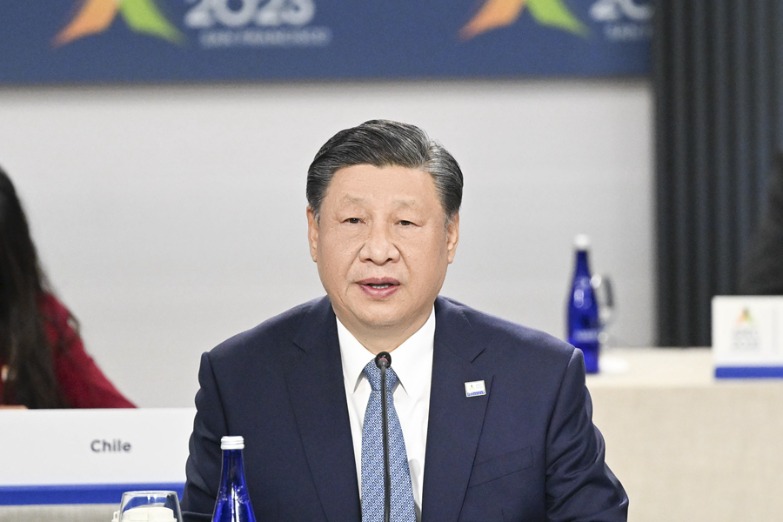


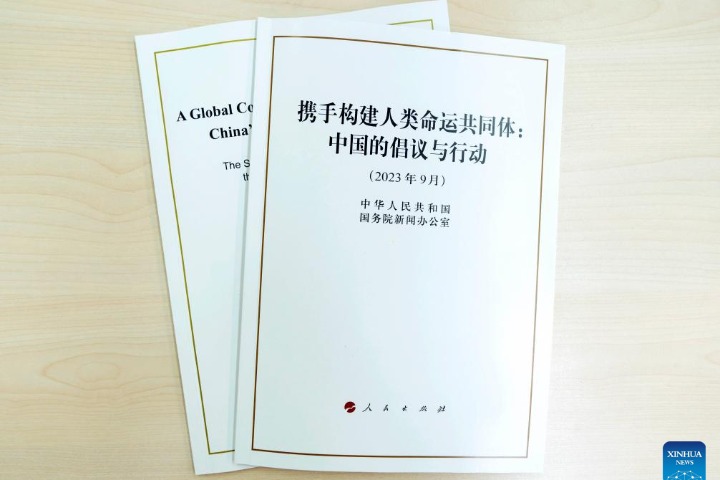
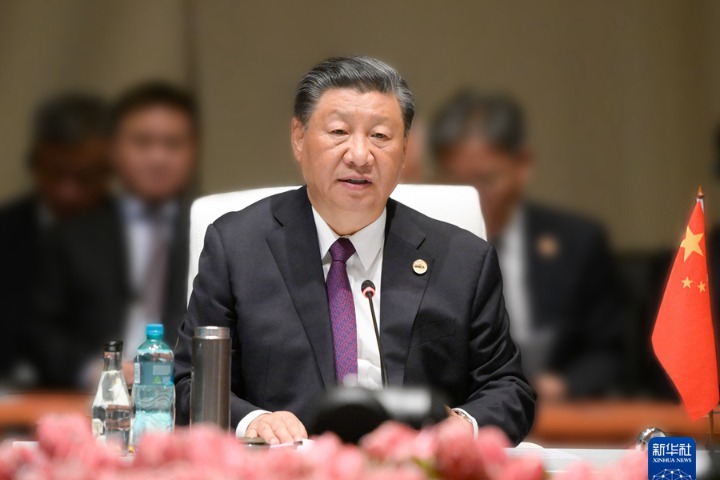



 英语点津微信
英语点津微信 双语小程序
双语小程序